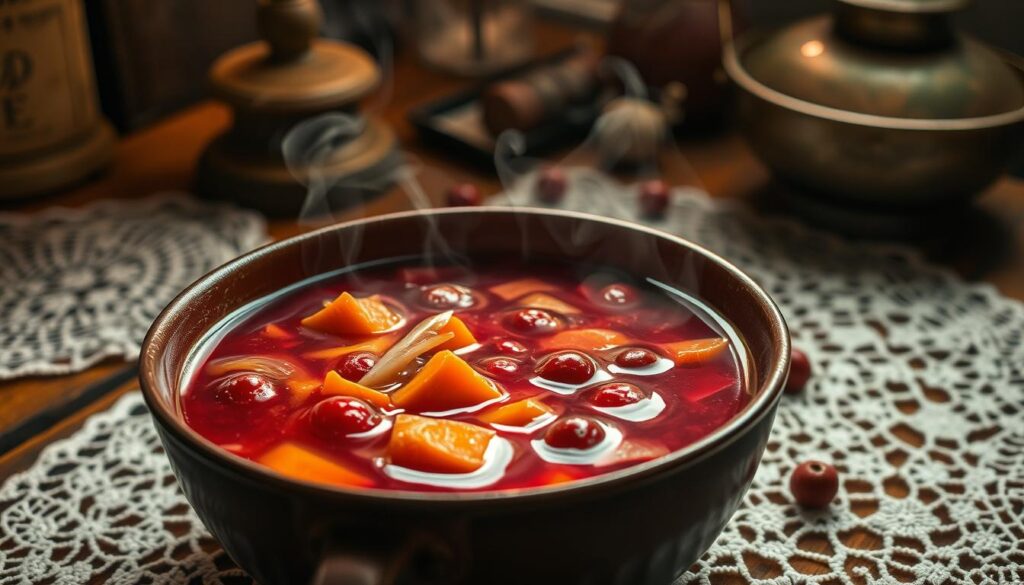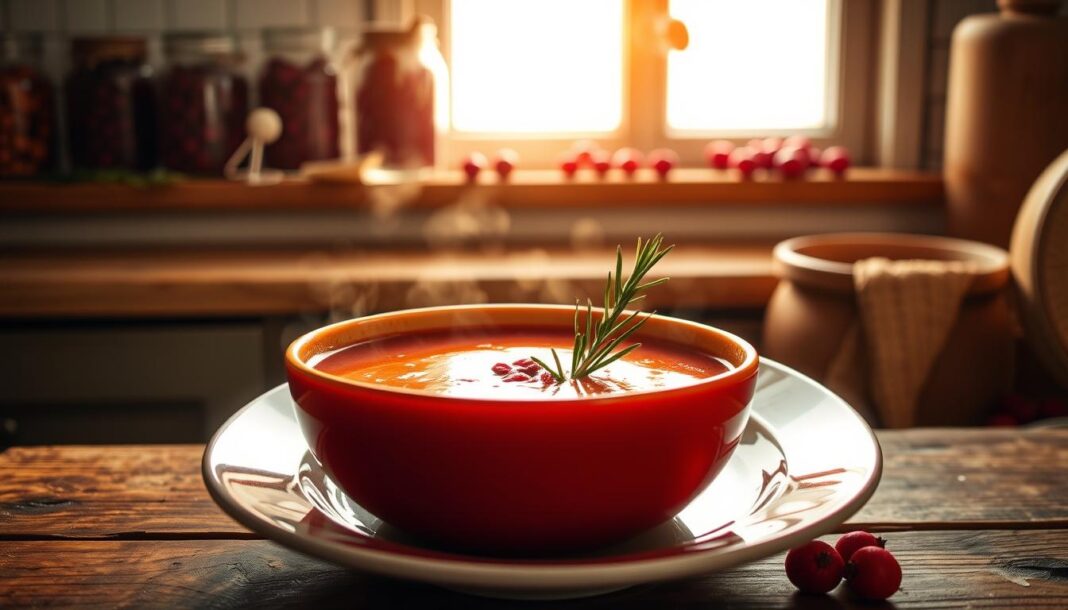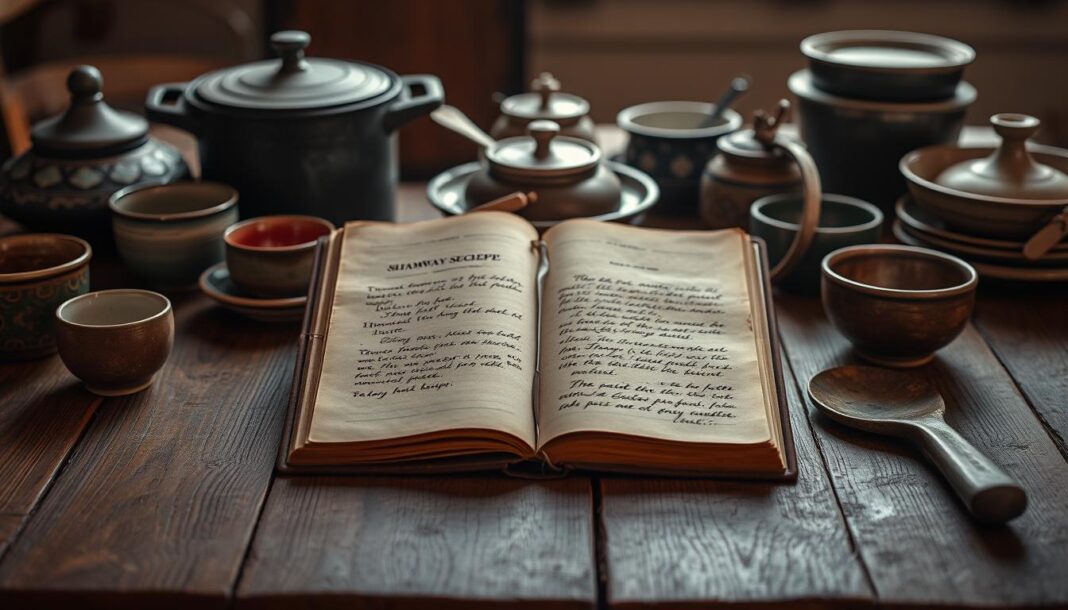We explore the delightful world of rosehip soup, a traditional Nordic delicacy that deserves wider recognition for its unique taste profile and impressive nutritional benefits.
This traditional soup has been cherished for generations in Swedish food culture, not just for its flavor but also for its high content of vitamin C and antioxidants, making it a perfect blend of comfort and nourishment.
Our comprehensive guide will walk you through the step-by-step preparation process of this traditional recipe, balancing the natural tartness of rose hips with just the right amount of sweetness.
Key Takeaways
- Discover the rich cultural heritage of rosehip soup in Nordic cuisine.
- Learn how to prepare authentic rosehip soup with our tested recipe.
- Understand the nutritional benefits of rosehips, including high vitamin C content.
- Explore the versatility of rosehip soup as a breakfast, snack, or dessert.
- Find out how to balance the tartness and sweetness in rosehip soup.
The Rich History and Tradition of Rosehip Soup
For centuries, rosehip soup has been a staple in Swedish cuisine, evolving through time. This traditional dish has been shaped by various cultural and culinary influences, making it a fascinating example of how food traditions adapt while preserving their essential character.
Swedish Origins and Cultural Significance
Rosehip soup originated in Sweden, where it has been a cherished family recipe for generations. The soup was not only a comforting meal but also a way to utilize the nutritious rosehips that grew abundantly in the region. The cultural significance of rosehip soup in Sweden is evident in its continued presence in Swedish cuisine, reflecting the resourcefulness and culinary creativity of Swedish cooks.

How Rosehip Soup Evolved Through Time
Over time, rosehip soup recipes have undergone significant changes, reflecting shifting culinary trends and available resources. Gustafwa Björklund’s 1847 cookbook marked a notable shift by excluding raisins and wine while introducing potato starch as a thickener, creating a recipe that closely resembles modern preparations. The addition of cream in the late 19th century added a luxurious touch, while the accompaniments evolved from wheat bread with butter, sugar, and cinnamon to sugary biscuits. This evolution demonstrates how rosehip soup has been continuously reinvented, maintaining its traditional roots while embracing new flavors and techniques.
Health Benefits of Rosehip Soup
As we explore the health benefits of rosehip soup, it becomes clear why this traditional dish has stood the test of time. Rosehip soup, made from the fruit of rose plants, is not only a comforting meal but also a nutrient-rich food that offers several health benefits.
High Vitamin C Content and Nutritional Value
Rosehip soup is particularly notable for its high vitamin C content, making it an excellent choice for boosting the immune system. The rose fruits used in the soup are rich in vitamins and minerals, contributing to its nutritional value. According to research, the unique combination of rosehip compounds may enhance the body’s ability to absorb and utilize these beneficial nutrients. This makes rosehip soup a great reason for families to incorporate it into their diet, especially during seasonal changes.
Antioxidant Properties and Wellness Benefits
The antioxidant properties of rosehip soup are another significant aspect of its health benefits. The antioxidants contained in rosehips have been scientifically proven to have anti-inflammatory effects, which can help in managing conditions like arthritis and other inflammatory diseases. Regular consumption of rosehip products, including rosehip soup, may contribute to improved cardiovascular health by helping to lower cholesterol levels and regulate blood pressure. This makes it a valuable addition to a family‘s dietary regimen, promoting overall wellness and health.
Harvesting and Preparing Rosehips for Soup
Harvesting and preparing rosehips is an art that directly impacts the quality of your rosehip soup. The process involves several crucial steps, from identifying the right rosehips to cleaning and processing them for use in your recipe.
Identifying the Best Rosehips to Pick
When it comes to selecting rosehips, the best ones are typically those that are ripe and have a vibrant color. These are usually found on rose bushes that are free from pesticides and other chemicals. The ideal time to pick rosehips is after the first frost, as this enhances their flavor and nutritional content.
Cleaning and Processing Fresh Rosehips
Once you’ve gathered your rosehips, it’s essential to clean them thoroughly. This involves removing any seeds and hairs that can cause irritation. To do this, we typically cut the rosehips in half and scoop out the seeds and hairs. After cleaning, the rosehips are ready to be used in your rosehip soup recipe.
Using Dried Rosehips or Rosehip Powder
If fresh rosehips are not available, you can opt for dried rosehips or rosehip powder as a convenient alternative. Dried rosehips require rehydration before use and may need a longer cooking time to extract their full flavor and nutrients. The conversion ratio between fresh and dried rosehips is typically 3:1. While rosehip powder is the most convenient option, our tests have shown that it lacks some of the complexity and brightness of soup made with whole rosehips.
For those interested in drying their own rosehips, the traditional Swedish method involves drying whole or halved fruits in a warm, dry place or a low-temperature oven until they are completely moisture-free. This method allows you to enjoy rosehip soup year-round while preserving the beneficial compounds of the rosehips.
Classic Rosehip Soup Recipe
Rosehip soup is a treasured tradition in many cultures, and we’re excited to share our classic recipe with you. This nourishing soup has been enjoyed for generations, and its rich history and numerous health benefits make it a wonderful addition to any meal.
Ingredients You’ll Need
To make our classic rosehip soup, you’ll need the following ingredients: dried rosehips or rosehip powder, water, potato, sugar, and potato starch. You can adjust the amount of sugar to your taste, and consider using alternatives like apple juice for a different flavor profile. Don’t forget to have a pinch of salt on hand to enhance the flavors.
For a more refined soup, you may also want to have a fine sieve and a hand blender or regular blender ready for use.
Step-by-Step Cooking Instructions
Start by boiling the rosehips or rosehip powder in water until they’re soft. Then, purée the mixture using a blender or hand blender until smooth. Strain the mixture through a sieve to remove any remaining solids.
In a separate pot, mix the strained rosehip mixture with diced potato and cook until the potato is tender. Add sugar to taste, and adjust the consistency with potato starch mixed with a little water. Bring the mixture to a gentle heat, stirring constantly, until it thickens.
Reduce the heat to low and let the soup simmer for a few minutes. Serve warm, garnished with a sprinkle of sugar or a dollop of whipped cream if desired.
Tips for Perfect Consistency and Flavor
Achieving the perfect consistency is key to a great rosehip soup. We recommend aiming for a silky and moderately thick texture that coats the back of a spoon but still flows freely. If your soup becomes too thick, you can thin it with a little water or apple juice while gently reheating.
For the best flavor, start with less sugar than you think you need, then gradually add more until you reach the perfect balance. You can also experiment with different sweeteners like honey or maple syrup for a unique twist. When using rosehip powder, simmer it for 10-15 minutes to develop a richer flavor.
Serving and Enjoying Your Rosehip Soup
Serving rosehip soup is an art that combines tradition, creativity, and a touch of Swedish heritage. We can enjoy this nutritious dish in various ways, making it suitable for different occasions and preferences.
The traditional Swedish way to serve rosehip soup is warm, accompanied byalmond macaroonsand a dollop of whipped cream. To make these macaroons, combine 100g of ground almonds, 35g of desiccated coconut, 100g of icing sugar, a pinch of vanilla powder, and two egg whites. This recipe yields approximately 80 small cookies that provide a delightful textural contrast to the smooth soup.
Rosehip soup offers remarkable versatility in serving temperature – it can be enjoyed hot, at room temperature, or chilled. For a luxurious touch, serve with vanilla ice cream or crème fraîche. Historically, rosehip soup was accompanied by bread toasted with butter,sugar, and cinnamon. For a modern twist, garnish with fresh mint leaves or a sprinkle of rose petals. The soup stores well in the refrigerator for up to five days and can be frozen for longer storage, making it a practical option for busy households.
By incorporating these serving suggestions, we can enhance our rosehip soup experience and connect with its rich culinary heritage.


